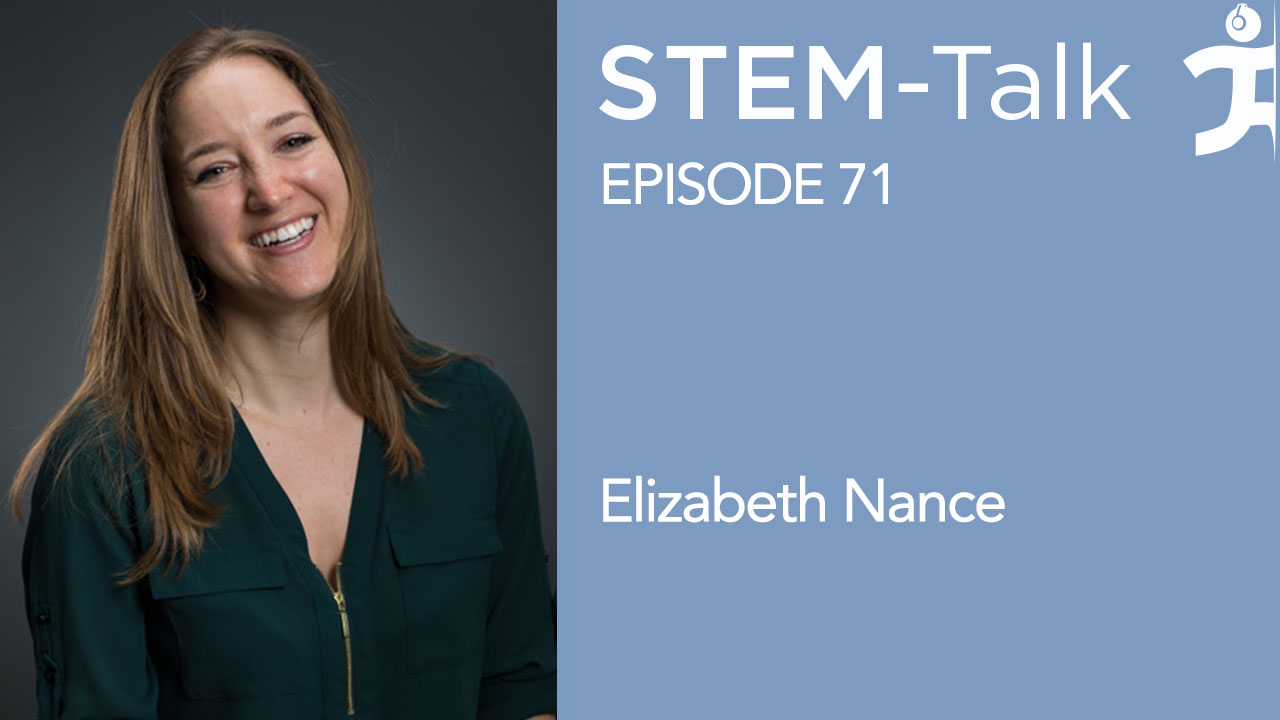STEM-Talk
Episode 71: Elizabeth Nance talks about using nanotechnology to understand and treat brain diseases
// Aug 28, 2018

Episode 71: Elizabeth Nance talks about using nanotechnology to understand and treat brain diseases
SEO: Elizabeth Nance, Nance Lab, University of Washington, nanotechnology, autism, traumatic brain injury, epilepsy, nanoparticles, blood-brain barrier,diffusion,dendrimer-NAC conjugates,Einstein’s brain, chemical engineering,Ken Ford,Dawn Kernagis,IHMC
Our guest today has been described by Forbes magazine as one of the “most disruptive, game-changing and innovating young personalities in science.”
Dr. Elizabeth Nance is known for her passionate search to find ways to more efficiently connect resources and information across multiple scientific and engineering disciplines. Her research focuses on using nanotechnology to understand the movement of molecules in the brain. She is particularly focused on better ways to treat brain diseases like autism, stroke, traumatic brain injury and epilepsy.
Elizabeth is the Clare Boothe Luce Assistant Professor of Chemical Engineering at the University of Washington. She also has an adjunct appointment in the school’s radiology department. Elizabeth and her lab, the Nance Lab, recently was awarded a $1.8-million-dollar grant from the National Institutes of Health to develop quantitative, high resolution imaging and analysis platforms to understand nanoparticle behavior, with a specific focus on the brain.
In today’s episode, we discuss:
- The pushback Elizabeth received in college when she tried to apply chemical engineering to neurological diseases. [00:11:33]
- How Elizabeth developed the first nanoparticles that could penetrate deep within the brain. [00:13:52]
- The many potential applications of nanoparticle technology in the treatment of neurological disorders, diseases and injuries. [00:17:10]
- The structure, and unique functions of the blood-brain barrier. [00:28:11]
- The dendrimer-NAC conjugates, and how they increase intracellular glutathione to reduce injury in the inflamed brain. [00:35:01]
- How “disease directing engineering” has the potential to allow for the leveraging of common hallmarks of neurological disease to better deliver therapies. [00:40:19]
- How change in brain metabolism affects targeted therapeutic deliveries to a specific region of the brain. [00:52:14]
Show notes:
[00:03:31] Elizabeth talks about growing up in North Carolina and how her family goes back nine generations to the original homesteaders of Charlotte. [00:04:06] Dawn mentions that Elizabeth liked to spend a lot of time outdoors as a child and asks her if it is true that she was especially good at climbing trees. [00:05:12] Dawn asks Elizabeth about her hectic schedule in high school, which, in addition to her studies, included soccer, track and volleyball. [00:06:03] Ken asks Elizabeth when she became interested in science. [00:08:22] Dawn mentions how in North Carolina a person has to decide early on if they are a Chapel Hill fan or a North Carolina State fan. Dawn asks if this culture contributed to Elizabeth going to NC State. [00:09:28] Dawn asks Elizabeth about her decision to major in chemical engineering. [00:11:33] Dawn asks Elizabeth to discuss the pushback she received in college when she tried to apply chemical engineering to neurological diseases. [00:13:52] Ken mentions that Elizabeth developed the first nanoparticles that could penetrate deep within the brain. This was a major reason why Forbes named her one of its “30 Under 30 Disruptive Influencers in Science” back in 2015. He asks if she could talk about the work she did in developing that platform and how it changed the way we might think about delivering drugs in the brain. [00:17:10]Ken mentions that there are many potential applications of nanoparticle technology in the treatment of neurological disorders, diseases and injuries. He asks Elizabeth to describe the structure of a nanoparticle in general, and how it can accomplish targeted delivery of a therapeutic. [00:21:47] Ken comments on how after publishing her nanoparticle paper in “Science Translational Medicine” in 2012, one publication commented that they were worried about potential nefarious applications of such technology. [00:25:23] Dawn asks why research and development for drugs used to treat people with injured or diseased brains take about 35% longer to develop than drugs for any other type of disease. [00:28:11] Dawn asks Elizabeth to give some background on the structure, and unique functions of the blood-brain barrier. [00:29:57] Ken discusses how a lot of Elizabeth’s work involves the use of nanotechnology and its potential applications in both understanding and treating the injured brain. He asks about the use of nanoparticles as probes, and how that helps us better understand the human brain microenvironment. [00:32:11] Dawn comments on how much of Elizabeth’s post-doctoral work focused on the use of dendrimer-based nanoparticles in multiple different settings as a model for how to approach neurological disease treatment. Dawn asks Elizabeth how that has informed her current research. [00:35:01] Dawn brings up how Elizabeth has published multiple papers on the dendrimer-NAC conjugates, and how it increases intracellular glutathione to reduce injury in the inflamed brain. Dawn goes on to say that some people have begun to take NAC to increase glutathione in the brain after a concussion or TBI. She asks Elizabeth to talk about the potential problems with giving NAC in the setting of excitotoxic brain injury, and why the use of a nanoparticle might be a potential solution to this problem. [00:37:30] Ken comments on how Elizabeth is known to be fascinated by diffusion, to the point where she has said that it has kept her up at night. He asks why understanding diffusion is so critical to overcoming the barriers to investigating and treating the injured brain. [00:40:19] Dawn mentions that a number of things that happen after brain injury can dramatically alter our ability to deliver a therapy. She points out that Elizabeth has coined the term “disease directing engineering” to describe an approach that has the potential to allow for leveraging of common hallmarks of neurological disease to better deliver therapies. She asks how that thought process informs the research in Elizabeth’s lab. [00:43:37] Ken brings up one of Elizabeth’s review papers, where she summarized how nanoparticle properties affect movement within the brain, and from that she developed a formula with the highest likelihood of success. He asks what that formula is. [00:46:16] Dawn comments on Elizabeth being very vocal about the drug delivery field’s movement toward increasingly complex delivery vehicles despite the limited translation of these approaches in the clinic. She goes on to ask why there is this gap. [00:48:34] Dawn mentions that Elizabeth and her lab were recently awarded a $1.8 million grant from the NIH, and how she will be using the grant to develop quantitative high-resolution imaging and analysis platforms to understand nanoparticle behavior and compartmentalization on brain tissues. [00:49:45] Dawn asks if Elizabeth could explain the idea behind her current work, which focuses on integrating biological data from the molecular level all the way up to animal behavior. [00:52:14] Ken comments on how we know that in certain types of brain injury or disease, that metabolism and inflammation are significant components of the underlying pathophysiology. He asks if a change in brain metabolism affects targeted therapeutic delivery to a specific region of the brain. [00:54:47] Ken asks if the leakiness of the blood brain barrier that occurs in certain forms of neurological injury and disease can be utilized in a targeted way to deliver a drug in the brain. [00:56:54] Ken asks what Elizabeth sees as the most exciting up and coming areas of nanoparticle therapeutics research and development. [00:58:20] Dawn asks Elizabeth about her decision to join the University of Washington. [00:59:40] Dawn asks if Elizabeth’s adjunct position in the department of radiology helps her interact with clinicians or medical researchers who might wonder why a ChemE is working on the brain. [01:00:49] Dawn asks if Elizabeth can expand on her idea that while interdisciplinary research is frequently talked about, that people are usually just giving it lip service. [01:02:37] Dawn mentions that Elizabeth’s father was a minister, and her mother a nurse, and that one thing they instilled in her early on was that every person and conversation has value; and that a person has to be constantly willing to go outside their comfort zone in order to grow. She asks how these lessons shaped the philosophy behind Elizabeth’s lab. [01:03:56] Dawn brings up a TED Talk that Elizabeth did where she stressed that we have made significant advancements in treating disease because of better prevention, better surgical intervention, and better diagnosis. But despite all this, we are still struggling to understand the majority of complex diseases, and that it is possible that we already have the tools we need to solve those problems but our approach to using them might be the issue, and that we might have the solutions already but we are just asking the wrong questions. [01:05:06] Dawn mentions Elizabeth’s shift from ChemE to neuroscience and pediatrics after her Ph.D. led people to ask her on a regular basis, “What are you? What is your specialty?” Dawn asks if that is why Elizabeth often refers to herself as a glorified match maker? [01:06:41] Dawn refers back to something Elizabeth said in her TED Talk about the idea of “specializing in not specializing”, and asks her to expand on that concept. [01:08:28] Dawn asks Elizabeth about recently being named the European Union’s NanoMed Innovative Training Network’s Inspiring Young Investigator of 2018. [01:10:08] Ken mentions that Elizabeth was recently on a podcast where she shared a remarkable story about how pathologist Thomas Harvey kept parts of Einstein’s brain after performing the autopsy on him in 1955. Some of the sections of the brain were recovered and analyzed decades later, showing that the structure and composition of his brain might have been slightly different from what we might normally expect to see. Ken asks if Elizabeth could discuss what those differences were and how this highlights the importance of probing. [01:12:40] Dawn mentions that episodes 47 and 48 of STEM-Talk featured a two-part interview with Tommy Wood, a UK trained physician and Ph.D. who now also works at the University of Washington. When Dawn and Ken asked Tommy what brought him over to the U.S., he said “a girl.” Dawn asks Elizabeth if she knows something about that. [01:13:31] Even though Forbes named Elizabeth one of its “30 under 30 in Science” in 2015, Dawn mentions that she understands Elizabeth was terrible at chemistry in high school. Dawn wraps up the interview by asking Elizabeth if that’s true.Links:
Elizabeth’s University of Washington faculty page
Elizabeth’s podcast interview where she talks about Einstein’s brain
Systems-level thinking for nanoparticle-mediated therapeutic delivery to neurological diseases
Tommy Wood STEM-Talk interview, episode 47
Tommy Wood STEM-Talk interview, episode 48






